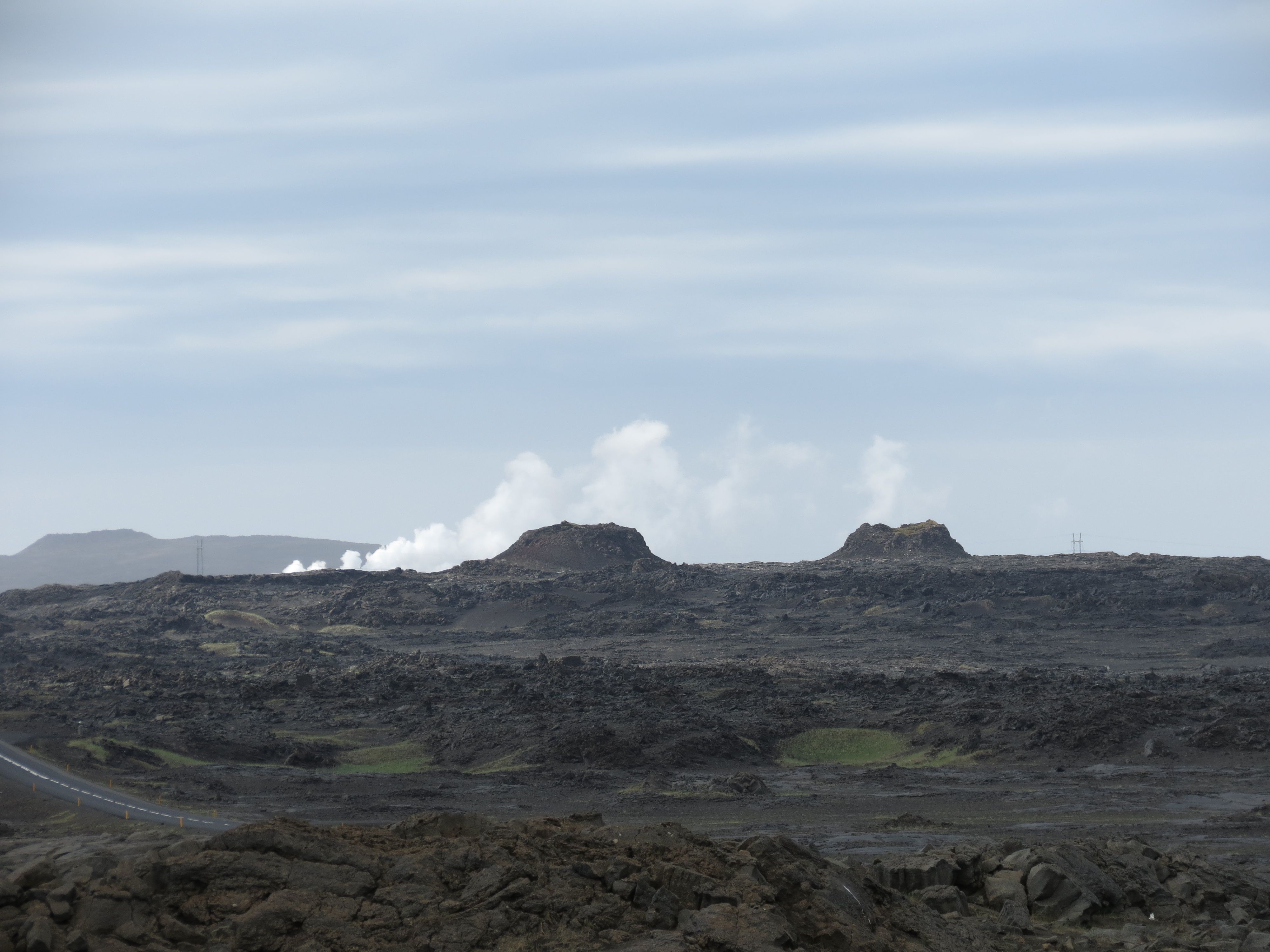
|
–Geoff-Hart.com: Editing, Writing, and Translation —Home —Services —Books —Articles —Resources —Fiction —Contact me —Français |
by Geoff Hart
Previous installment: June 26th in Reykjavic
We had a much better sleep last night (nearly 8 hours), though the room’s radiator was doing this endless annoying clicking noise. It occurs to me belatedly that the reason why there’s no airconditioning is that in Iceland, where the temperature rarely rises to 20°C, there’s not often much need for it. Still, this leads to a bit of architectural high-tech silliness in our hotel: the only way to cool the room is via a small transom window. It’s too high to reach (about 10 feet up), so it’s operated by an electrical switch labeled only "Window", with up and down arrows, to raise and lower the glass panel. It’s too small for really effective ventilation, but worse than that, it automatically closes after 5 to 10 minutes. (We later learned that the hotel’s wind sensor had malfunctioned and was closing the windows prematurely. It took two tries, but we finally managed to persuade them to reprogam the damned thing and tonight, writing up the day’s blog entry, it seems like that’s done the trick. The room is pleasantly cool.) In my rarely humble opinion, sometimes it’s just silly to use technology for such tasks when it would have been easier, less expensive, and more effective if they’d put the openable part of the window down at human level and trusted us to know when to open and close the pane. (Yes, some folk would undoubtedly forget and leave it open during a rainstorm, but since it’s a hotel, the cleaning staff would figure this out by midmorning, when they come to clean the rooms, with little or no harm done.)
Today our goals were to see more nature (geology and birds) and experience some nurture; that is, today we donned hiking boots to explore a wild area of the Reykjanes Peninsula near Reykjavic, then ended the day by pampering ourselves at a spa, followed by some bus tourism to relax on the way home.
Dick, our intrepid tour leader, apparently has experience with adults behaving badly, so he wisely set up a schedule for sitting in the front seat of the bus. That’s where you get the best views, and therefore it’s a coveted spot that some folks might otherwise be tempted to hog. This morning, it was our turn to sit that particular secular throne. (The view was great, but the footroom was negligible, thus it was uncomfortable, if not quite the Iron Throne of "Game of Thrones".) When we moved back to the second row of seats in the afternoon to let others take their turn, the seats were more comfortable and the view nearly as good.)
It started off looking to be another gorgeous day, with blue sky and a few clouds. I got so much sun yesterday that I switched to a full-length shirt rather than short sleeves. As it subsequently clouded over and became quite windy, that proved to be a suitable choice. Yes, we’re way north here, but 10 hours out in the endless sun is still going to get you tanning. We ended the day again in beautiful sunshine.
The Reykjanes Peninsula stretches south and west of Reykjavic, back towards Keflavic Airport, where we arrived. It’s an endless and mostly flat sea of lava, alternating between relatively smooth pahoehoe (pronounced “pahoyhoy”) lava, which forms flattish beds, often with ropy curls, and heaps of a'-a' (ah, ah) lava, which is like jumbled piles of cobbles and shards. Pahoehoe is good hiking terrain, as its mostly obstacle free; a'-a' is basic ankle-breaking terrain, with few flat surfaces, and it's easy to get lost if the lava's heaped high, because you can't take your eyes off the footing for a second, and you can't necessarily get a clear sightline for where you're going. So mostly you won't hike in a'-a' terrain. Here, it’s all the same basalt material, and the difference relates to the temperature when it formed: the smooth stuff is hotter and therefore flows smoothly, whereas the clumpy a'-a' is cooler, so it breaks into chunks as the leading edge cools and stops flowing, blocking the lava behind it, which then spills over the top, creating more heaps as it, in turn, cools. One of the group suggested that the difference between the two was like the difference between pouring soup and pouring undiluted porridge, which seems a pretty good description.
Pedogenesis (soil formation) is very slow here, presumably because of a combination of cold temperatures, which slow the weathering process, and high rainfall (50+ inches per year), which leaches away fine particles that would otherwise form soil and any organic matter that accumulates. Thus, the lava in this area (ranging from 800 to about 5000 years old, depending on the place) is mostly still recognizably lava rather than soil. Most of it is covered with heaps of moss, which (along with lichens) is the first plant to colonize fresh lava. The local moss is a drab grey-brown in color in drier areas, where it nonetheless forms extensive patches that fill the gaps between lava chunks like water filling a field of boulders. It's the more familiar to this Canuck greener color in wetter areas. It seems to propagate quite well once it establishes a toehold, because it absorbs the water rather than letting it percolate deep into the cracked and porous lava, where it would be lost to surface plants. There are some areas covered with hearty grass, but it’s clearly clinging for life to the surface of the lava gravel. There’s not a lot of soil, but where there is, the grass is richer and the people graze sheep and cattle, with some horses. (We’ll be seeing the Iceland's famous horses tomorrow.)
We stopped mid-morning for an opportunity to clamber over the lava and up to the top of a spattercone, a small volcano that spits up tons of small lava blobs that form small rocks, and because the pressure isn't so high, the spatter doesn't travel far. The cone rises irregularly in height as the cooled blobs rain down around it. There was a surprising amount of vegetation in the heart of the dead spattercone, at least in part because we’re near enough to the coast that some of the sand carried onshore by waves is blown into the crater, where the wind can't reach it, leading to the formation of a primitive soil. So there were half a dozen or more species of tiny flowers (including Iceland's national flower, the mountain avens), some miniscule junipers creeping along the ground, and a “bonsai” willow a couple inches high trying to survive the harsh location. Another reason pedogenesis is so slow is that initially, there are few plants to weather the soil with their root exudes or crack apart large pieces through the physical pressure caused by the roots, and there are very low inputs of the organic matter that's necessary for soil fertility. Once the plants get bigger and become safely established, soil formation speeds up and more demanding plants can become established.
Here's what spattercones look like from a distance and up close:

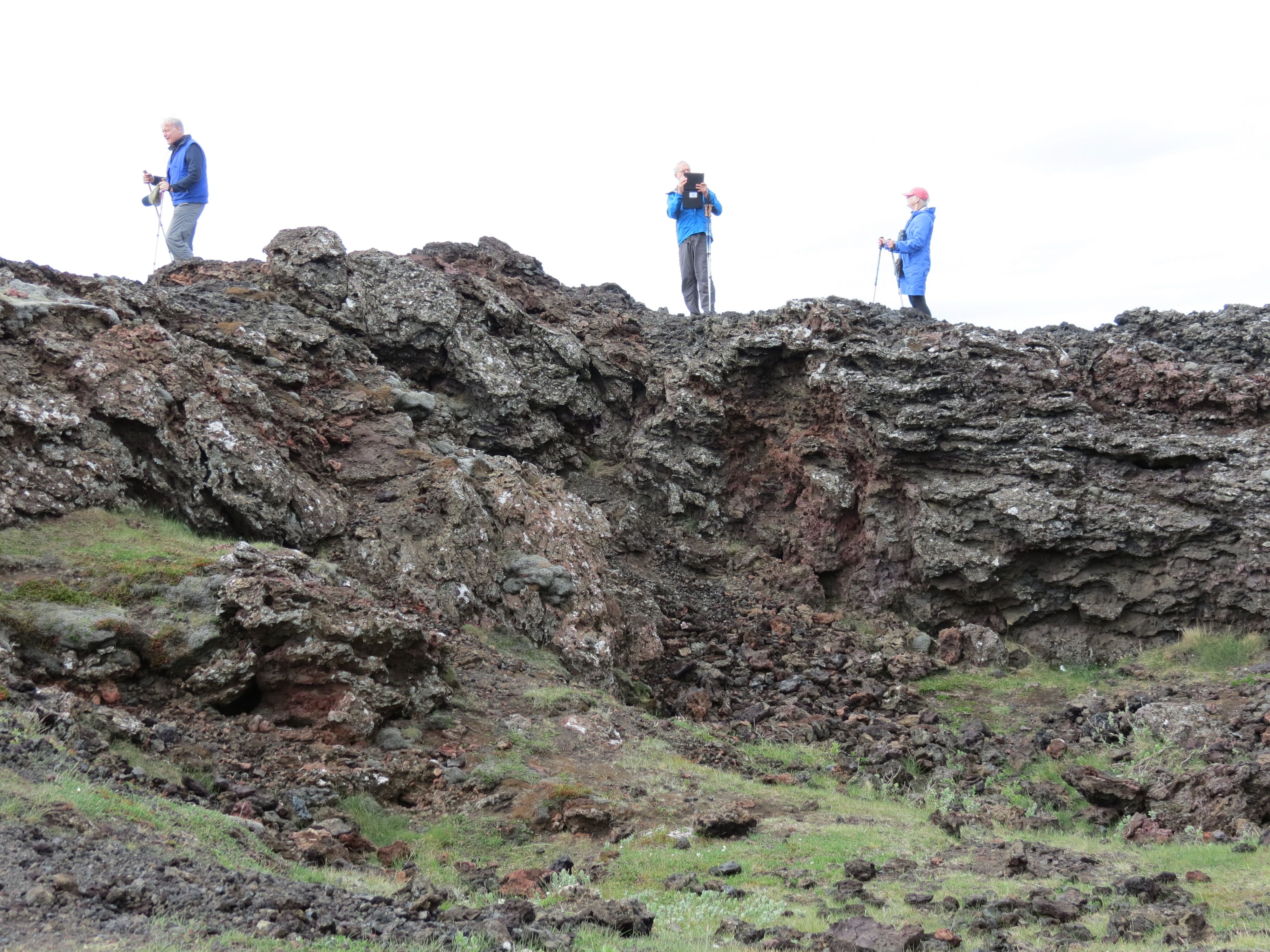
(Side note about birds: We'll be seeing puffins in coming days; they don't hang out in this part of Iceland because there isn't enough soil for them to dig nests. I appreciate birds but don't know them well, so all bird IDs here courtesy of Sarah, our resident birder. We saw many arctic terns, a flock of swans, several redwings, several waggletails, inumerable herring gulls, many blackwinged gulls, plus a solitary raven kwok-kwoking his complaints to anyone who would listen and possible a kitiwake gull. Gudrun told us the birds are very late arriving this year because there’s been a predominantly north wind, which stops most of them from flying north; they prefer having a tailwind from the south because it's a long and difficult flight from the nearest land.)
After the spattercones, we detoured a bit off the main road to see the "bridge between the two continents", which crosses a rift where the Eurasian and North American plates are spreading apart. It's not as dramatic as what we'll see in a couple of days (stay tuned!), but still fascinating for what it represents. Here's the bridge and its rift:
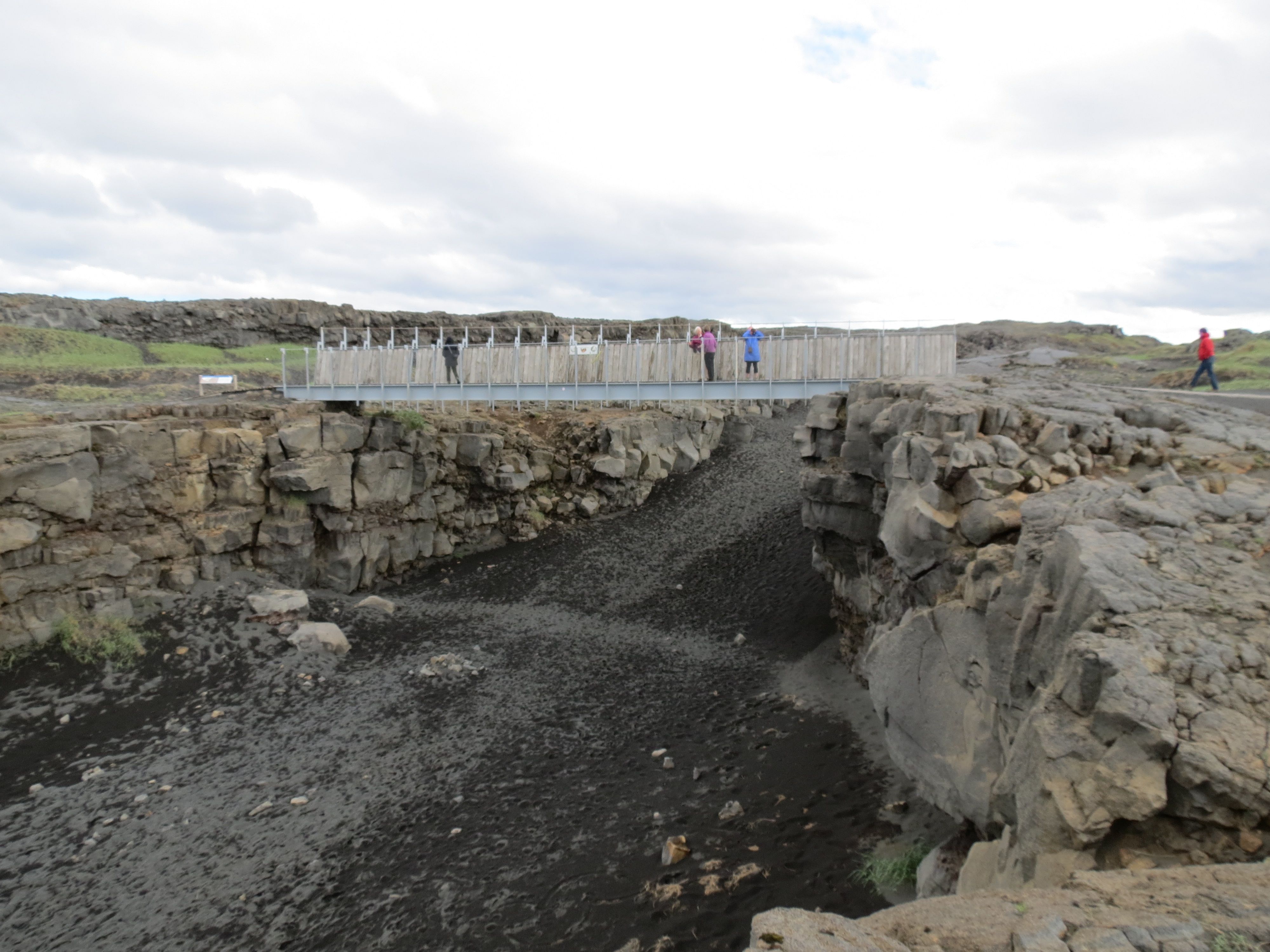
Our next stop was the shore near Grindavik, Iceland’s fishing capital. This is where the herring and cod fleets gather their harvest. The cod boats are quite amazing; they apparently can unreel 50 km (!!!) of line, with 5000 hooks, when conditions permit. This year, they've already reaped their cod harvest quota, and are on shutdown until at least August. One of the more unusual Icelandic exports is “cod heads”, which they air-dry in enormous racks on the lava fields and then ship to Africa, where they’re apparently a delicacy. We had a blustery clamber down a trench leading to a boulder-strewn beach, where Dick showed us some more of the complexity of volcanic terrain: a thick layer of ash overlain by a distinct layer of smooth lava that had flowed over top of the ash. Here's a shot of the coast and of Dick showing us the lava layers:
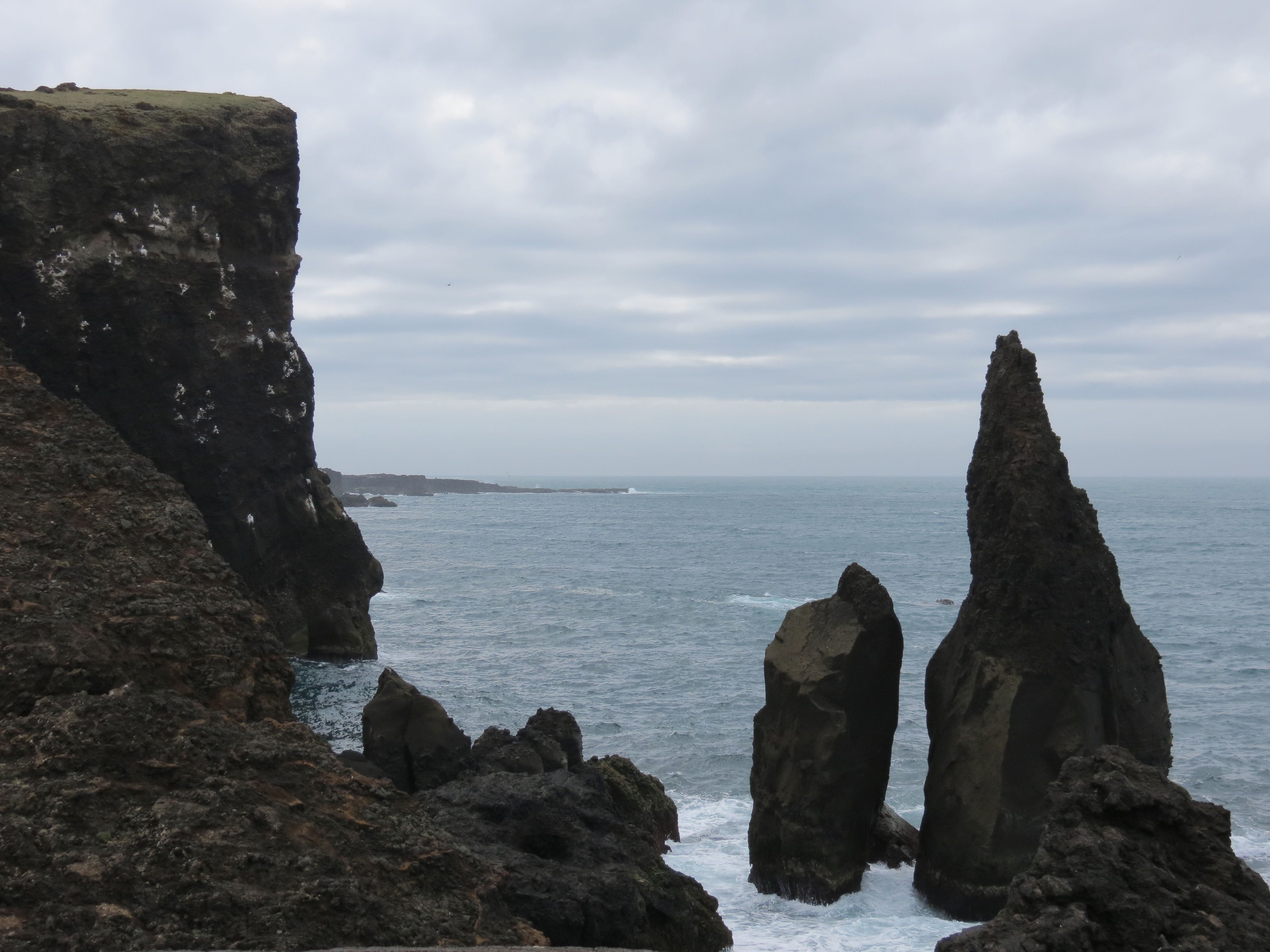
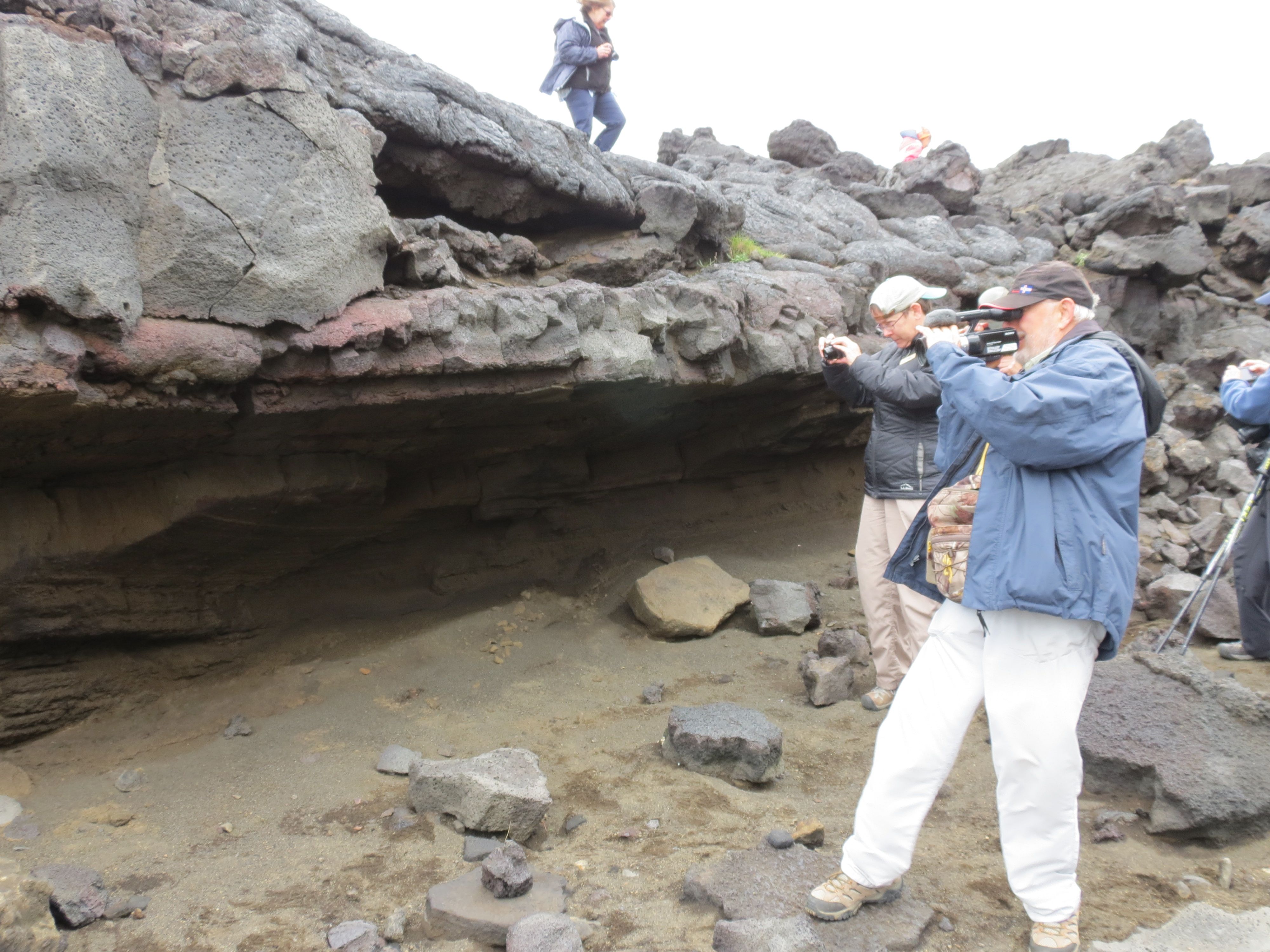
Lunch was hearty soup and rye bread at the Bryggjan Café (named after the Icelandic word for barley, brygga). The host was a man who’d spent his life making nets for the fishing fleet, and taken up the café business as a kind of hobby. While we ate, he showed us the art of splicing cut rope (an inline splice) and forming a permanent loop (a backsplice). I’ve done this before, long ago, when I took sailing lessons, and could possibly figure out how to do this again with a little work; this guy did it far faster than I’d ever dreamed of doing on my best day, and he did it without really paying much attention because he was telling us about himself and what he was doing. Quite amazing
Our next stop was the Blue Lagoon, a famous geothermal spa that was created as a way to use up the waste heat and water from the local geothermal power plant. This spa has become such a popular stop for tourists that most Icelanders no longer go, both because of the crowds and high cost and because you have to reserve time in the spa well in advance; demand far outstrips the space available for spa-goers. The men's locker rooms had lockers numbered up to 180; the women's side presumabily similar. They're already building a large expansion "lagoon". Gudrun told us the huge influx of tourists is becoming a huge infrastructure problem; there aren't enough buses to go around (we were supposed to get a bus with a washroom, but it was allocated to someone else), hotel capacity is becoming an issue (our hotel manager tried to talk Dick into moving us to another hotel), and a great many homes are being transformed into bed and breakfasts or similar accommodations. Great for the economy, of course, but it will inevitably have all kinds of ripple effects on Iceland's society.
The Blue Lagoon name comes from the high load of suspended silica in the water, which gives it a pleasant milky blue color. Wisps of steam drift past, and it’s quite salty, but not much in the way of sulfur smell. As you do at a Japanese onsen (their version of hot-spring spa), you need to shower and wash down completely before entering. After leaving the showers, you have to gather your courage to walk across the chilly deck, where you hand your towel in the towel racks. But then you slip into the deliciously warm water, where you’re surrounded by (I’d guess) a couple hundred other bathers; I recall the signboard saying the lagoon holds 6 million liters of water, and it seemed to cover about an acre. The water ranges from a few inches deep around the edges to chest deep towards the middle. Here's a shot of the lagoon after we'd done bathing:
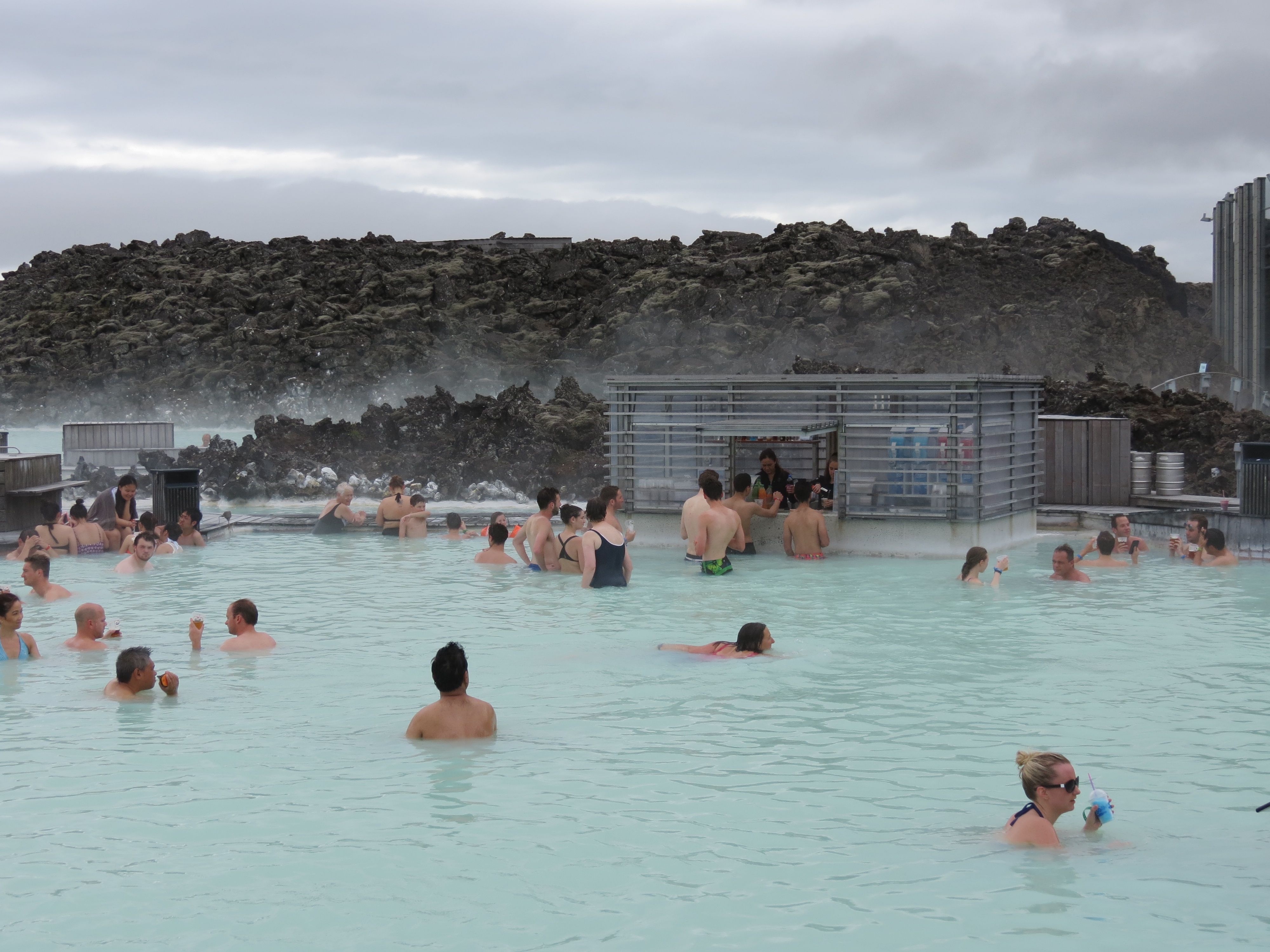
Particularly near the inlets, there are currents of significantly hotter water that are a real balm to aching muscles after a day spent on air travel or hiking in lava or city streets. The water and silica mud that creates the color are mineral-rich, and supposed to be very good for your skin, so they have great pots of the stuff at various locations around the edges of the lagoon. You schmear the stuff onto your face or body, let it dry, then rinse it off. I skipped the mud treatment, but had nonetheless had a good wallow with Shoshanna for something like an hour and a half, emerging all pruney-fingered and greatly relaxed. Here's Shoshanna dun up in silica muck:
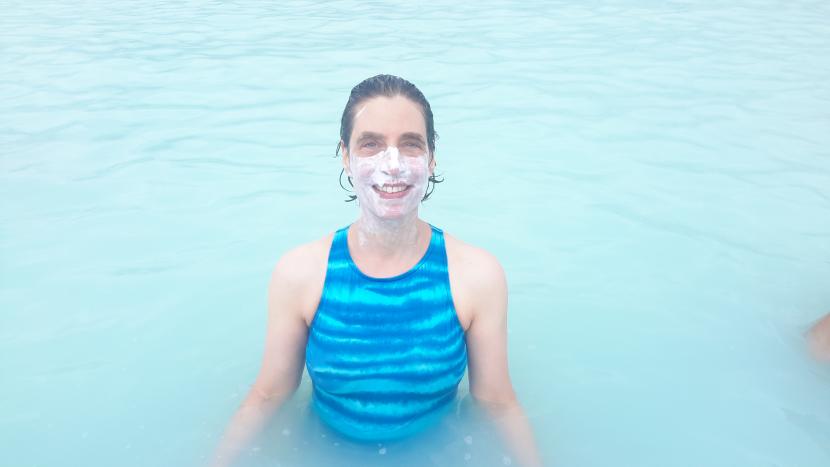
They’ve got quite the merchandising operation going. One young lady circulates, carrying a tray of the mud but also a tray of moisturizer for after you’ve rinsed it off, and when you're finally done for the day and leave, as might be expected, you leave through the gift shop, where you have time to buy some of the moisturizer and myriad other products of the spa before you leave. There’s also a swim-up bar where you can buy (overpriced even by Icelandic standards) beer and other drinks, a small café right next to where you exit the water if you're feeling peckish, and a restaurant should you feel in the need for something more substantial. Plus, there are multiple levels of service you can purchase, ranging from our spartan level (just a free towel and access to the pool) to deluxe packages that include bathrobes, in-pool massages, and free drinks.
From the Blue Lagoon, we headed home on a road that runs along the south shore of the Reykjanes Peninsula, heading back east and then north to Reykjavik. It’s a pleasantly rocky shore, with waves crashing against the beaches and cliff, creating blossoms of spray large enough to be visible from several kilometres away. More lava terrain, but covered with deep beds of moss. En route, we stopped at a pleasant little notch in the hills filled with fumaroles, bubbling away like a row of teakettles amidst blue-grey expanses of clay. Steam rises both from the obvious open holes and some more permeable patches of ground. There's a pleasant sulfury smell, like freshly lit wooden matches, and occasional sulfur crusts where the water had boiled away and left its residue. Lower down the hills, there's a lot of clay, which in full sunlight has a beautiful blue-grey sheen. Fumaroles for your viewing pleasure:
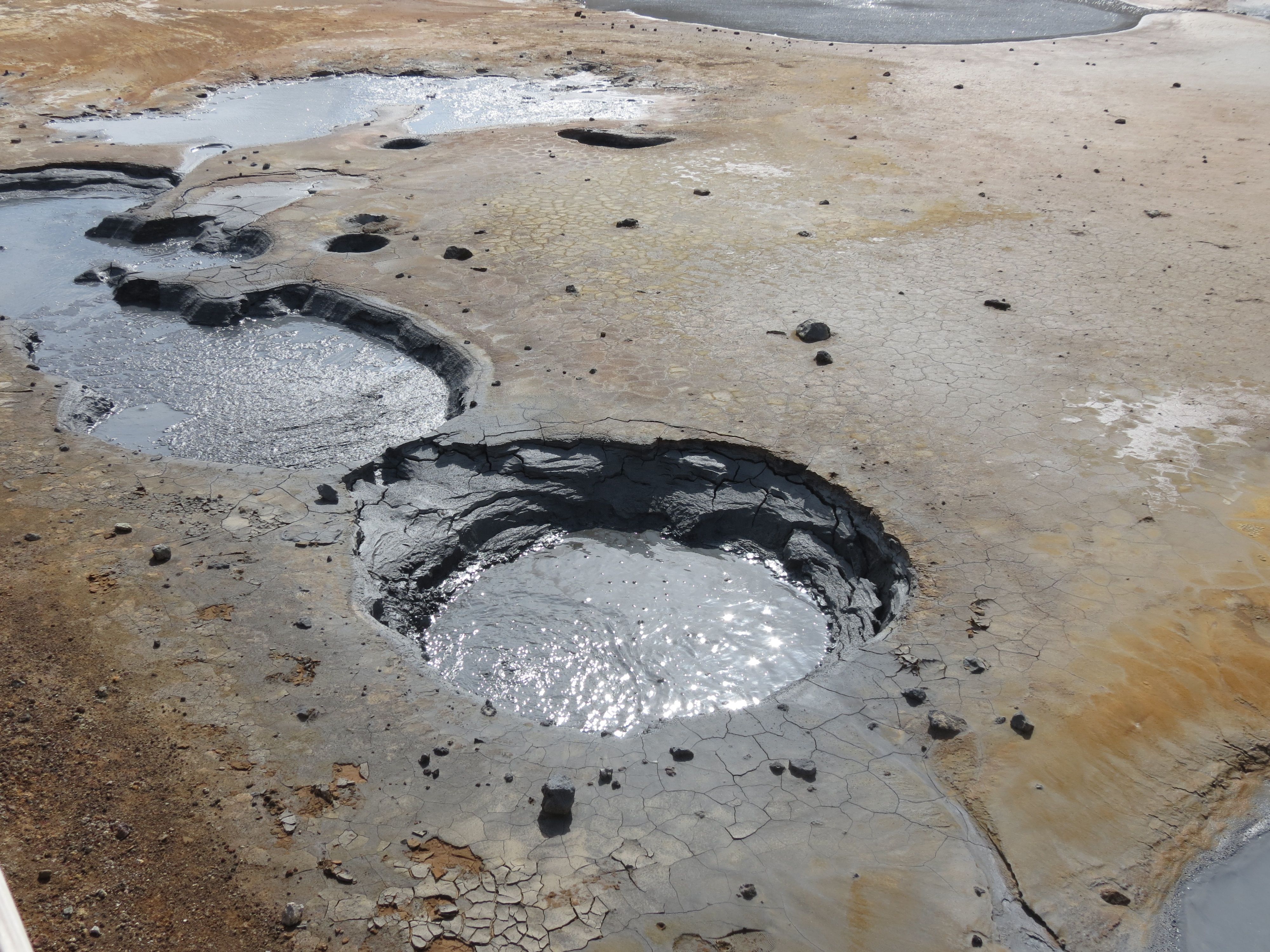
Our last stop was at Kleifarvatn ("steep slope water"), a long lake flanked by beautiful hills. It’s quite a large lake, stretching about 5 km (crude eyeballed estimate from our tourist map). Amazingly, during an earthquake a few years ago, the bottom cracked and the lake drained away, nearly disappearing, as if someone had pulled the plug from a giantn bathtub. It’s recovered nicely. Here's a nice shot along the lake:
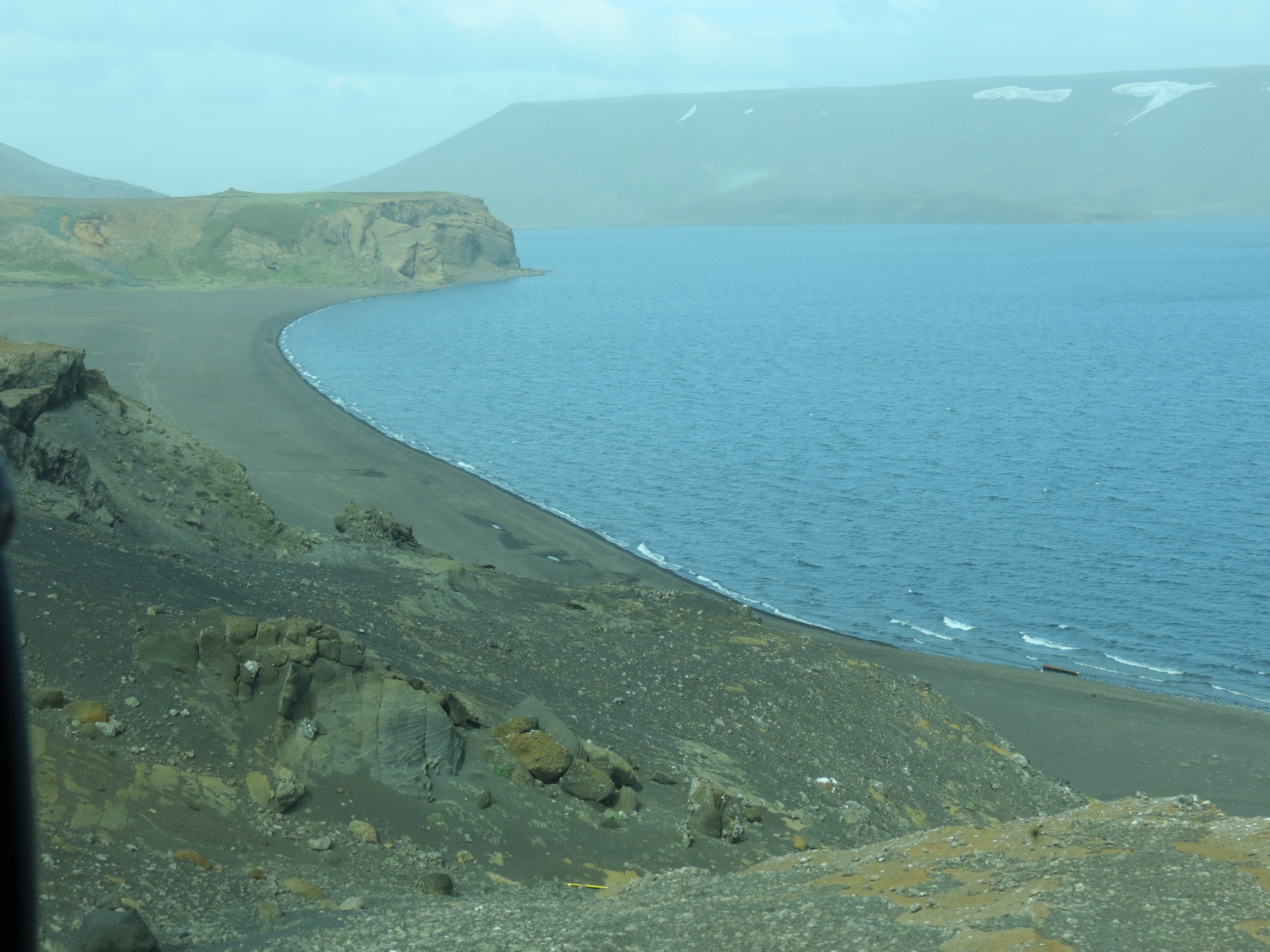
On the way home, Dick suggested that we try out the Florana Café for dinner, as it's about half an hour walk from our hotel, nestled amidst the Reykjavic Botanical Gardens. It sounded nice, so as soon as we hopped off the bus and said goodbye to Gudrun (who was a charming, knowledgeable, and very patient guide), off we went. The Asmunder Sveinsson sculpture garden is right next to the hotel and along the way, so we stopped to enjoy some art before dipping down into the Botanical Garden. A couple dozen statues, large and small, are just sitting right out in the garden for all to see; all are interesting and several are quite lovely. Here's an interesting example of one of his abstracts, which seems to be a man trying to tame a horse:
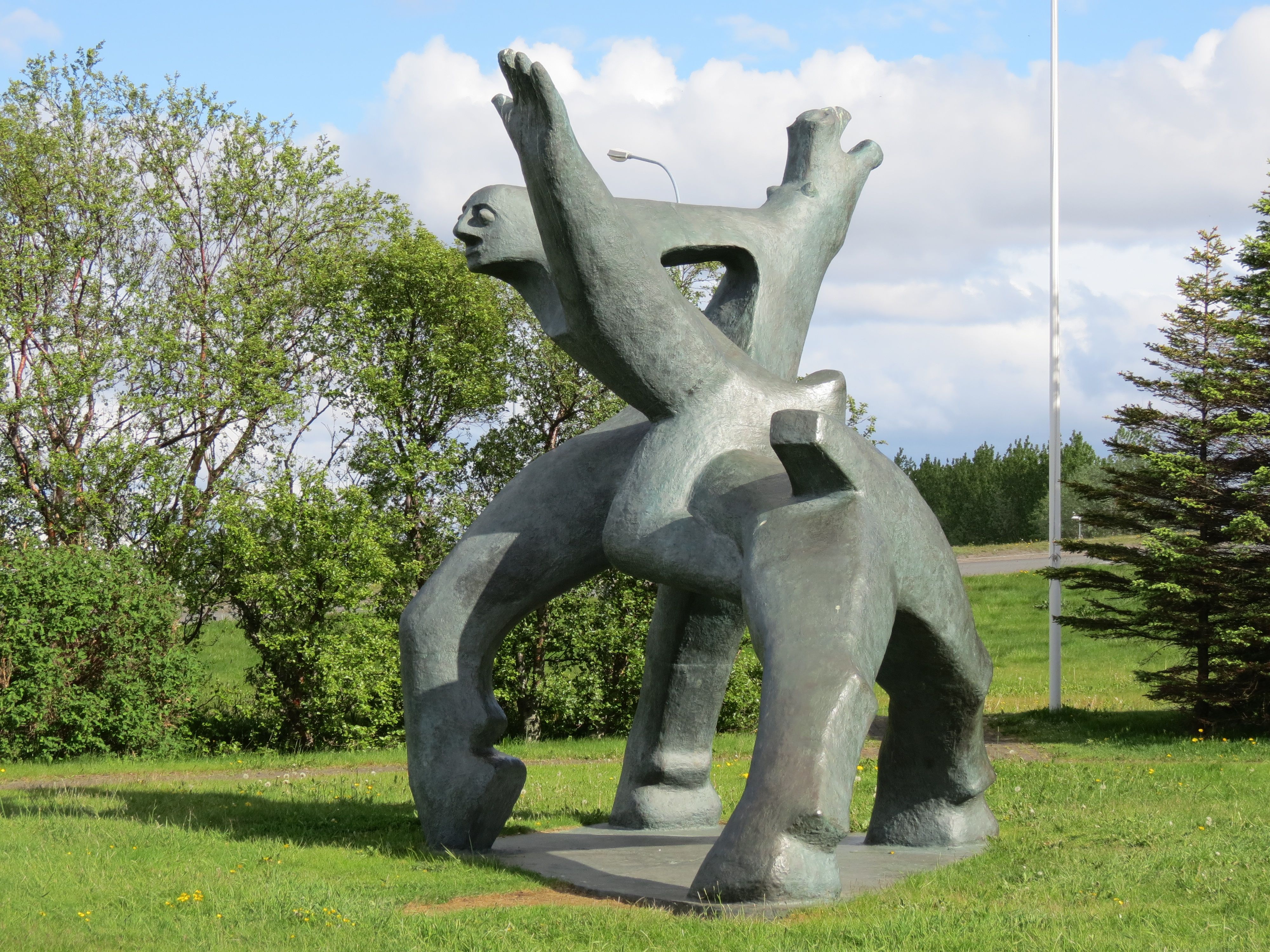
As we passed throught the park leading to the Botanical Gardern, Shoshanna was distracted by a historical display, and while she was reading, several other members of the tour group caught up with us. As they were heading to the café too, we joined forces and took some tables together. There were outdoor tables, but the sun was low enough it would have been right in our eyes, so we ate indoors instead; they have a dozen or so tables set up inside a greenhouse filled with arbors covered with flowering vines and surrounded by other plants, including one poor fig tree that is very far from home. Very pleasant ambience. I opted for the pulled pork on a thick slab of toasted rye, and it was delish: sweet barbeque sauce, tender pork, and some of the best rye bread I’ve ever had. Shoshanna went for toasted cheese, which was brie glazed with honey and topped with rosemary and cashews. Also yummy. Dinner was washed down with bottled Einstök Beer: a smoked coffee porter for me, and a Belgian white for Shoshanna (with nice hints of orange and cardamom). I think the Tuborg was still the best beer of the trip thus far, but both Einstöks were very tasty. I Was briefly tempted by a final beer for the road, but then I saw the desserts, and opted for a flourless chocolate cake instead. (I was able to pronounce the name -- frönsk sukkulathikaka -- well enough that the waiter smiled and understood what I was trying for. Yay amateur linguistics! *G*)
Home in time to type up the blog while still conscious and enjoy the non-sunset sunset. (It’s nearly 10 PM as I type this, and the sun is still well over the roofs of the six-story buildings across the street from us. An early-ish night for us, since we’re going whale watching and Icelandic pony riding tomorrow, and they come to get us at 8:15 AM.
Next installment: June 28: Whale watching and Icelandic horses©2004–2024 Geoffrey Hart. All rights reserved.